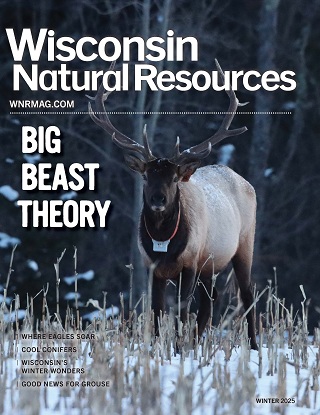Readers Write 2018
Wisconsin Natural Resources magazine encourages reader photos and feedback. Below, you will find letters that appeared in 2018 magazine issues. Reader letters from other recent years are available here:
Reader letters and other content from older issues of Wisconsin Natural Resources are part of the magazine archives housed in the UW-Madison Libraries Digital Collections [exit DNR]. (Note: Magazine content from 1996 and newer is being added to the UWDC site, so some of those years may be temporarily unavailable.)
We welcome your feedback! Email us at dnrmagazine@wisconsin.gov or mail to:
Readers Write
WNR magazine
PO Box 7921
Madison, WI 53707
Winter 2018
Winter 2018
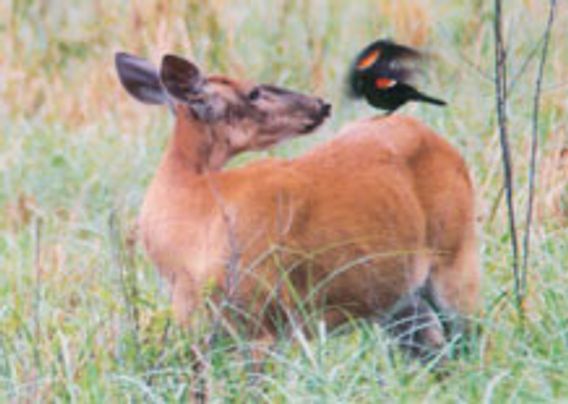
ANOTHER DEER AND BLACKBIRD TALE
This is a very late response to a letter in your October 2017 issue ("Symbiotic de-bugging"). I went to the park at 6 a.m. and saw a doe standing in a field with a red-winged blackbird on her back! It was slowly but steadily working its way up her back and neck to the top of her head and down her face, eating bugs intently. The doe looked so blissful.
After about 25 minutes of this, the blackbird fell off her nose. It flew back to her rear end, only to be met by another blackbird who wanted in on the action. There was a flurry of wings and the first bird won. I sadly ran out of film. This was in 1992 or 1993.
Karen Kropp
Milwaukee
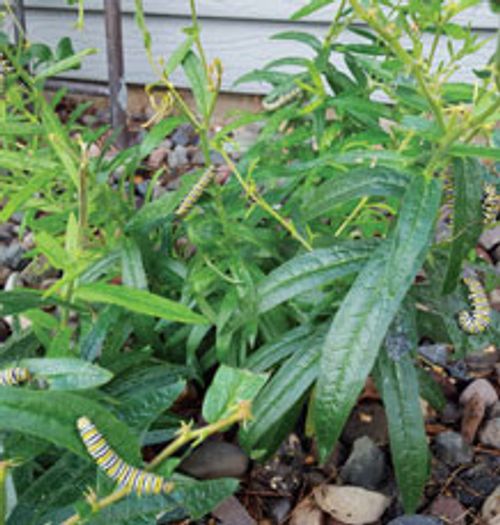
MUNCHING MONARCHS
While my wife was watering her flowers, she saw that she had 12 visitors on her butterfly weed. We are hoping maybe these guys are monarchs. Hungry little fellows anyway, I guess that's why they call it butterfly weed. Love your magazine!
Doug and Karen Kurschner
Almena
DNR conservation biologist Owen Boyle provides this reply: "Commonly referred to as butterfly milkweed, Asclepias tuberosa is our only native orange-flowered milkweed. Commonly planted in native plant gardens and prairie restorations for their beautiful orange flowers, monarch caterpillars clearly love them, too!"
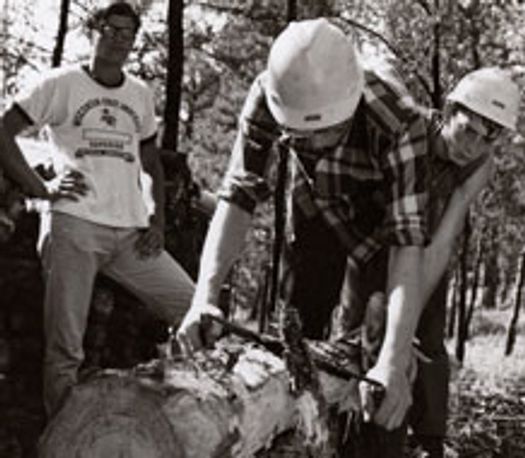 © DNR FILES
© DNR FILESSTORIES SPARK READER MEMORIES
I was reading the 2018 Fall WNR and enjoyed the stories about the history of DNR ("DNR memoirs"). It reminded me of the summer job in '69 or maybe '70 working in the Youth Conservation Camp at Lake Nancy in northwestern Wisconsin. Seems like it may have been six weeks long, and we spent a week on a certain task.
I remember walking through forest land pulling weeds (currant bushes, I think) to curb pine tree blister rust one week, cleaning and fixing trails in a state park a different week. Then back at camp we also had some sessions about fire control and other outdoor/wildlife activities. Free time was for swimming, fishing and other camp activities.
I remember it was a great job for 14- to 15-year-old boys who loved hunting and fishing. I came close to attending UW-Stevens Point for a conservation major, but went another direction. Anyway I enjoyed the issue, thanks.
Jim Sainsbury
Monona
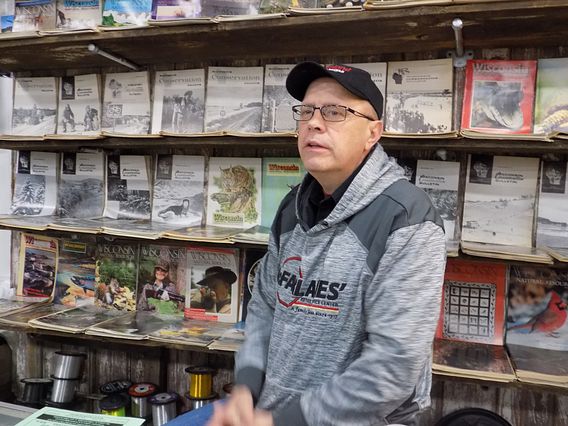 © ANDREA ZANI
© ANDREA ZANIKUDOS FOR 'HUNTER AND GATHERER'
I enjoyed reading the article about Wayne Whitemarsh (above) and his collection of Wisconsin Natural Resources magazines and Wisconsin Conservation Bulletins ("Hunter and gatherer," Summer 2018). My father, Jim Taylor, was a past editor of this magazine. As editor, he used the name J. Wolfred Taylor. Unfortunately, he passed away in 2014 at the age of 94. He would have been thrilled to know his work continues to be appreciated by others. Thank you for sharing this story.
Julie Taylor
Lake Mills
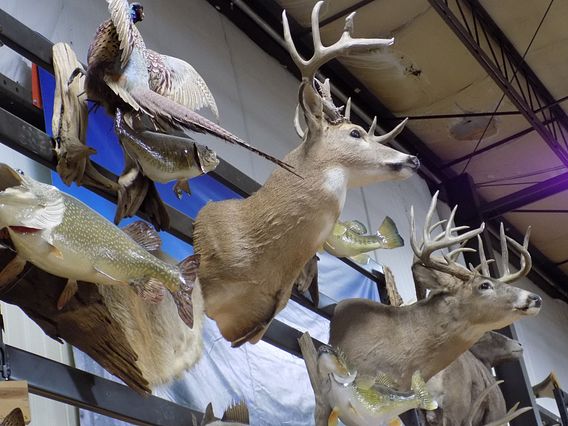 © ANDREA ZANI
© ANDREA ZANIWHITEMARSH STORY PROMPTS VISIT
A friend gave me a one-year subscription to your magazine; it was a wonderful surprise. Congratulations on producing such a terrific product that showcases Wisconsin resources.
I live in the Phoenix area but my heart is still with Wisconsin. Years ago, I graduated from UW-Stevens Point with a conservation major. It is a joy to see that Wisconsin still continues to be a leader in conservation and natural resource management.
I spent a week in Wisconsin this summer and got up to visit Wayne Whitemarsh at the McFarlane's True Value Hardware (above) in Sauk City. The article in your magazine ("Hunter and gatherer," Summer 2018) prompted me to make the visit — it was great! I gave him a book about Fran and Frederick Hamerstrom's research on prairie chickens to add to his collection. I had helped briefly with the research while a student at Point. Thanks for a job well-done!
John F. Knight
Sun City West, Arizona
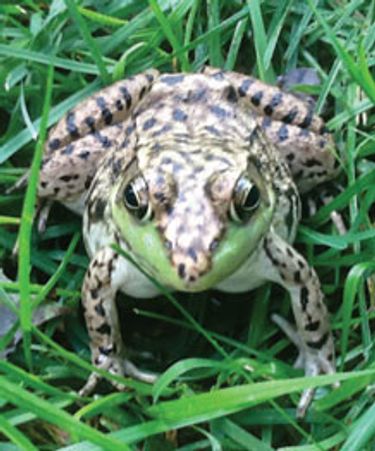
YOU CAN TELL FROM THE SMELL
Can you tell me what kind of frog this is?
Darrell Naze
Suamico
DNR conservation biologist Rori Paloski replies: "It is a bit tough to tell from the angle, but I believe it is a green frog, rather than a mink frog. Green frogs have more pronounced ridges on their sides/backs and the patterning on their legs resembles bars rather than spots. These two species are often very difficult to tell apart even when you have them in hand. One sure way to definitely tell if it is a mink frog is to smell it — mink frogs usually have a strong mink odor!"
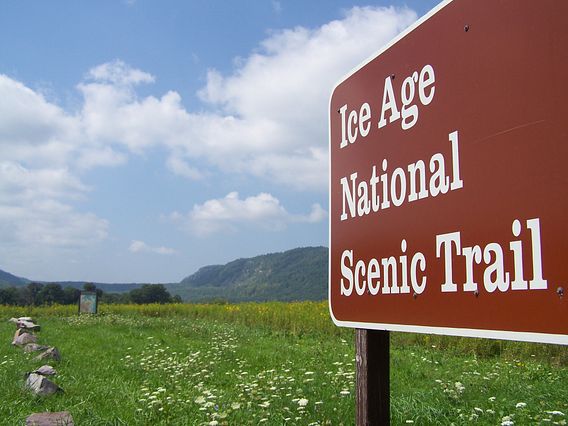 © JOE WARREN
© JOE WARRENGIVE OR TAKE A FEW THOUSAND YEARS
The Ice Age Trail article ("1,000 miles to remember," Fall 2018) states that the ice left Wisconsin 70,000 years ago. But the ice entered Wisconsin during the Wisconsin Ice Age about 70,000 years ago and didn't leave till 10,000 or 11,000 years ago. Thought you might want to clarify that. Not sure when the glacier was at maximum extent, maybe 35,000 years ago? If the trail follows the edge of maximum extent, then those features would be 35,000 years old or less.
John Balaban
Chicago
As John points out and the Ice Age Trail Alliance notes on its website, iceagetrail.org [exit DNR], the most recent period of the Ice Age, known as the Wisconsin Glaciation, did end about 10,000 years ago. There are "recent" deposits of gravel, boulders and soil from this period in nearly every county along the Ice Age National Scenic Trail. Areas of the trail in Green, Rock, Dane and Marathon counties were covered by earlier continental glaciations, the website notes, between 25,000 and 2.5 million years ago. And other geologic features along the trail date back more than a billion years!
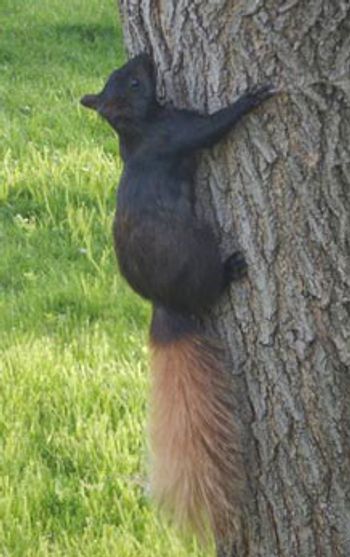 © ANDREW STASHEK
© ANDREW STASHEKBLACK SQUIRREL HOT SPOT
Hi. In the Fall issue of Wisconsin Natural Resources magazine I subscribe to was a notation from Mark Witecha, DNR upland wildlife ecologist, explaining about genetic mutations. While eating in a cafe a couple of summers ago in Reedsburg, I remarked on how many black squirrels I noticed and I was informed Reedsburg was the "Black Squirrel Capital of Wisconsin."
Any truth to this statement? Any hoot, I surely am impressed with the magazine for pictures and general info you all provide. Thank you.
Bob Honel
Tomah
Thanks for the letter, Bob. There doesn't seem to be any official designation regarding Reedsburg's black squirrel status, but reports like yours indicate they are widely seen in the area.
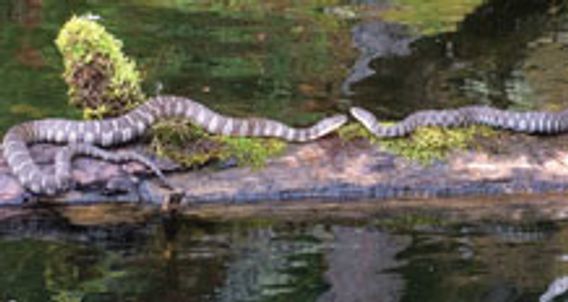
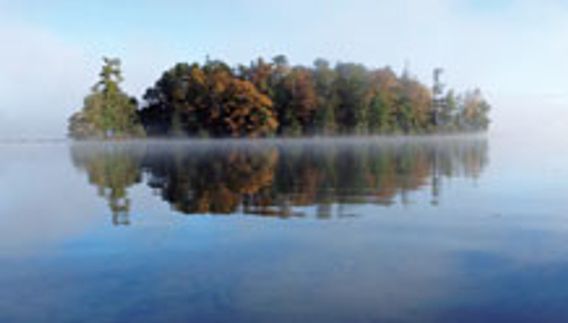
FAMILY FAVORITES
My family has a lake house on Ballard Lake in Star Lake, Vilas County (we are from Cincinnati) and are always collecting photos while enjoying the lake. These are a couple of our favorites.
The first was taken by my mother, Theresa Nurre, when she was kayaking on Ballard Lake in July 2017. She saw two northern water snakes sunning together on a log near our house. I took the second looking out at the island on Ballard Lake from our lake house early one morning in fall 2017 when the leaves were just starting to change.
We are subscribers and love the magazine! Thanks for your work!
Amanda Nurre
Cincinnati
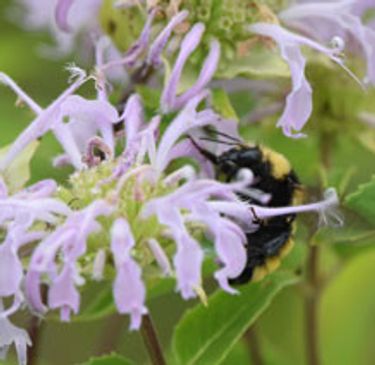 © JAY WATSON
© JAY WATSONBUMBLE BEE ID
In the Fall 2018 issue of the Wisconsin Natural Resources magazine, there is a picture of a bee on joe-pye weed on page 23. The bee is identified as Bombus borealis. Am I wrong in thinking it's more likely to be Bombus impatiens?
Ann Pedder Reilly
Janesville
This is yet another great example of an eagle-eyed reader being right on the money with species identification. In this case, a late switch was made with bumble bee photos in the magazine and the caption was not updated. The originally planned northern amber bumble bee photo (Bombus borealis), from DNR conservation biologist Jay Watson, is shown above. It turns out Ann is a member of the Wisconsin Bumble Bee Brigade, a new monitoring project that relies on volunteers to conduct small area surveys in which they look for, count and photograph bumble bees at a given location and submit a record of their observations. Volunteers are welcome for this important project; find out more on the website of the Wisconsin Bumble Bee Brigade [exit DNR].
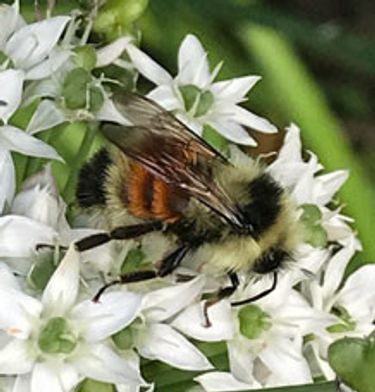
BUMBLE BEE ID II
Can you verify if this is the endangered rusty patched bumble bee? Many in my flower garden recently. Thank you.
Phyllis Lorenzo
Hayward
This is not the rusty patched bumble bee (Bombus affinis), which is listed as federally endangered and of special concern in Wisconsin, where it is rarely seen. Rather, DNR biologist Jay Watson responds, it is a male tricolored bumble bee (Bombus ternarius).
Fall 2018
Fall 2018
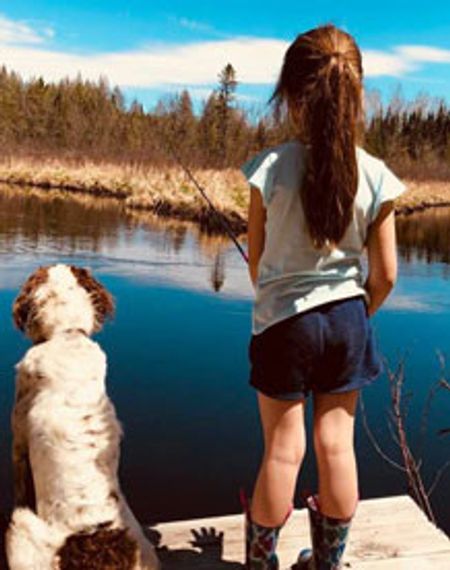
GIRL'S BEST FRIEND
This is a photo of our 5-year-old granddaughter with our Llewellyn English setter fishing with her mom on Armstrong Creek.
Ray and Connie Gudowicz
Armstrong Creek
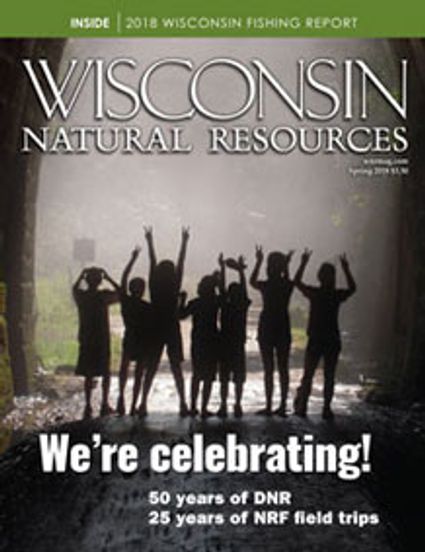
DNR CELEBRATION
What an absolutely gorgeous cover on your spring "celebration" issue! I can actually feel the joy and delight of the kids caught in a surprise rainstorm and having a wonderful old tunnel in which to ride it out. It's a perfect photo to celebrate not only DNR and the NRF field trips as you state on the cover, but also to celebrate the many years Wisconsin citizens have been able to enjoy your wonderful, educational publication. Thank you!
Sheila Wistad Fugina
New Richmond
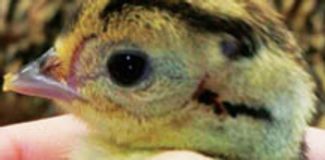 © DNR FILES
© DNR FILESBOY OR GIRL?
The pheasant hatchery story in the Spring 2018 issue ("Hatching success at State Game Farm") mentions sorting chicks by sex a few hours after they're born. How do you tell them apart?
Bill Dunn
Middleton
That's a great question, Bill! Kelly Maguire, supervisor at DNR's State Game Farm in Poynette, explains there is a slight difference in the area just in front of the eye of day-old pheasant chicks. "The male chick (shown above) has a small, bare patch of skin corresponding to the cheek patch or wattle of the adult. It looks like a semi-circular reddish line in the eye area."
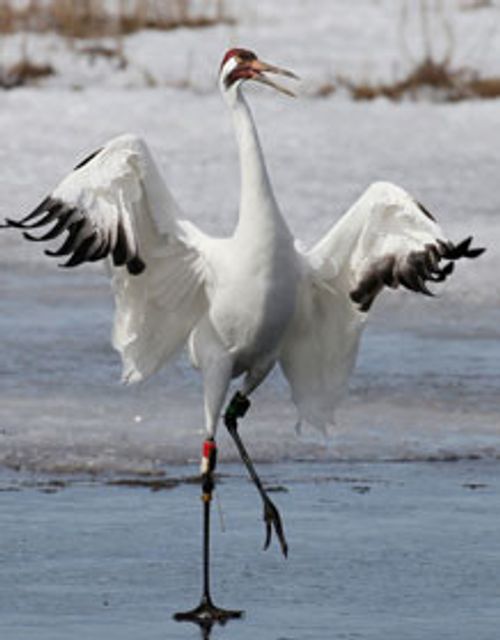
BUCKET-LIST WHOOPER
I just wanted to share this once-in-a-lifetime shot I got in late March. I had only seen whooping cranes last year at a very long distance at Horicon Marsh but that weekend we came upon this whooping crane very close to the roadside and watched two of them dance and interact with the sandhill cranes. It was so awesome to see and capture!
Heather Landers
Kaukauna
After sending Heather's sighting to DNR wildlife biologist Davin Lopez, he shared this information about crane #39-16, pictured, from the Operation Migration Inc. website:
Hatched June 1, 2016, and raised by whooping crane parents at a captive breeding center in Maryland, colt #39-16 was initially released in September 2016 in Adams County, where he remained until early December. The morning of Dec. 7, he left with a buddy (#29-16) and many sandhill cranes on a southward migration. They over-wintered in Dyer County, Tennessee, and returned north in mid-April 2017 to Chippewa County, Wisconsin, and then to Ward County, North Dakota.
These two males (known to observers as "Mutt" and "Jeff") returned to Wisconsin in early October 2017 and were selected to have two female parentreared chicks released near them. The release took place in Marathon County and while the foursome was observed together a few times, an official "adoption" did not take place. Male 29-16 and his pal 39-16 headed south again on Nov. 9 and by the 12th had returned to the previous winter's location in Tennessee. And as evidenced from Heather's photo, he was back in Wisconsin in late March 2018 on the Horicon Marsh.
The Whooping Crane Eastern Partnership is a nonprofit organization of individuals and government agencies dedicated to whooping crane recovery. Check out their website, www.bringbackthecranes.org, for more information, including what to do if you see a whooper.
 © DNR FILES
© DNR FILESYCC DEVELOPED APPRECIATION OF ENVIRONMENT
I am curious to know why there aren't YCC (Youth Conservation Camps) anymore. Back in 1974, I went to one near Clam Lake and it was one of the best experiences of my life! We did many conservation projects like tree planting, making small dams along waterways, built fire pits for campgrounds, pruned pine trees plus so much more.
We also had our hands-on educational times in the woods with our leaders learning about plants, animals, ecosystems. We also took some field trips, lived in dorms and had simple meals. We were paid a modest sum for our efforts and it was totally worth it. I think this would still really benefit teens nowadays to be more interested in preserving and appreciating our environment. What do you think? I would love to hear from someone there.
Lori Rowin
St. Croix Falls
The Youth Conservation Camp program was started in 1962 under the Conservation Department and was modeled after the post-World War II-era Civilian Conservation Corps. Over the YCC's 30-plus years, more than 24,000 high school-aged students spent summers at work camps across Wisconsin, such as Statehouse Lake (Vilas County), White River (Bayfield County), Ernie Swift (Washburn County), Mecan River (Marquette County) and Kettle Moraine (Washington County). In 1974, restrictions were repealed and girls were allowed to attend. By the mid-1990s, budget cuts, liability concerns and changing social norms were creating challenges to the program, and in 1995, the camps were closed.
Not only did young people benefit from their work experiences, but DNR properties did as well. Ray Hendrikse, YCC leader through much of the program's existence, said in 1986, "The simple truth of the matter is that without the assistance of the youth camps, development, restoration and maintenance of state parks, wildlife areas, forests, streams and lakes would be severely reduced. Without them, conservation work would continue to get done, but to a much lesser degree."
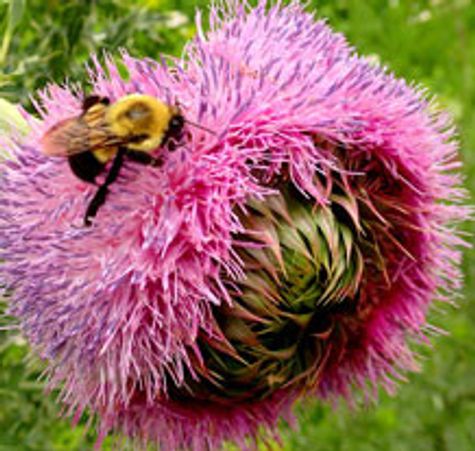
BEE-UTIFUL MUSK THISTLE
The bees were busy collecting pollen today in Vernon County. Some think thistles aren't pretty. I am a firm believer that beauty is in the eye of the "bee-holder."
Len Harris
Richland Center
Jay Watson, a DNR conservation biologist stationed in Green Bay, confirmed this is the common eastern bumble bee (Bombus impatiens). While he agrees that bumble bees indeed like musk thistle, he cautions that it is classified as invasive and restricted under NR 40. The restricted classification applies to "invasive species that are already established in the state and cause or have the potential to cause significant environmental or economic harm or harm to human health." Learn more about musk thistle on the DNR's musk thistle webpage.
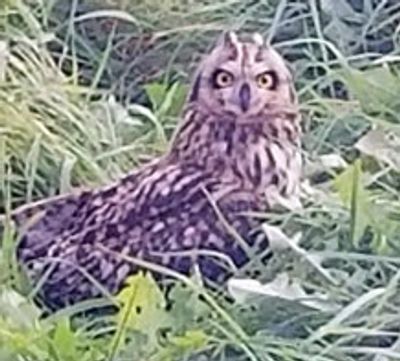
EYES ON THE PRIZE?
Last fall I arrived at my hunting land near Dallas, in Dunn County, and on my walk to reach my tree stand I encountered this visitor watching my every move. This short-eared owl was nestled amongst this grassland and by the look in its eyes, I really didn't feel a warm welcome to start my hunt. Seeing and listening to all the wildlife during my hunts provides me so much pleasure and appreciation for nature.
Tom Collins
Amery
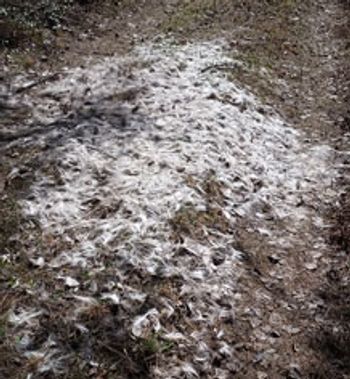
FUR CARPET
While hiking in the eastern part of Vilas County, we came upon this massive carpet of deer fur on and near the trail. We're curious why there would be so much in one area! My husband and I are both Conservation Patrons. We love the magazine and are proud to be patrons of conservation in this beautiful state!
Wendy Lutzke
Manitowoc
Kevin Wallenfang, DNR's big game ecologist, provides this explanation: "Most likely what they found is a spot where a deer succumbed to winter conditions or a predator kill. All flesh and bone have been carried off or decomposed, but hair can last for a long time. All that's left here is the hair."
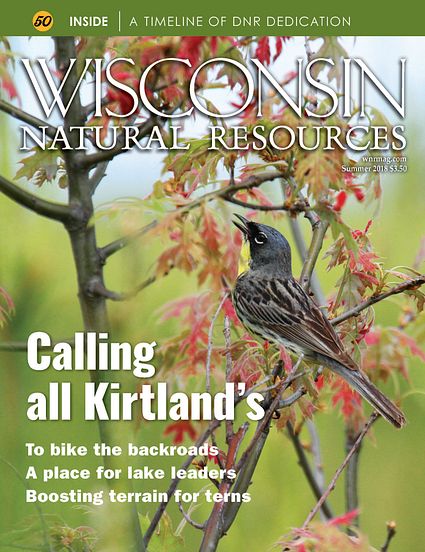
PLANTING WITH A PURPOSE
My wife and I are involved in the Illinois Forestry Development Act and have a plantation south of Wisconsin near Rockford, Illinois. With the idea of possibly attracting the Kirtland's warbler, we planted more than 500 jack pines about 15 years ago. Being a subscriber to Wisconsin Natural Resources, we were delighted to read the article "A happy tune" (Summer 2018) concerning this species. It is heartwarming to know that there are others with similar intention. We enjoy your magazine immensely and look forward to future articles!
Mark and Cece Dahlgren
Rockford, Illinois
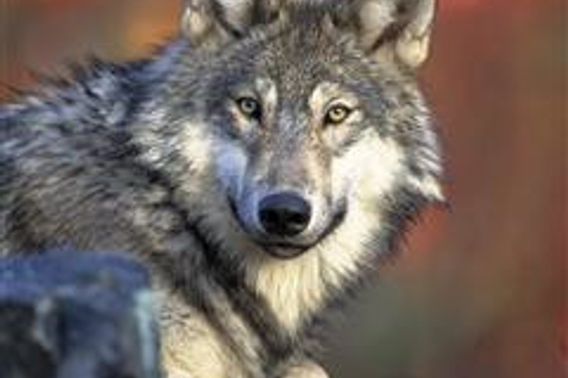 © DNR FILES
© DNR FILESSTUDENTS PUSH TO PROTECT ENDANGERED SPECIES
Magazine editors were heartened to receive about a dozen letters from fourth graders in the Stanley-Boyd School District. The students were given assignments to research endangered species in Wisconsin and write a letter to advocate for their protection. We received letters about wolves, whooping cranes, Hine's emerald dragonflies, piping plovers, northern long-eared bats, rusty-patched bumble bees, Canada lynx and eastern Massassauga rattlesnakes. Here's one of the letters.
Hi, my name is Macie LaGrander. I am here to inform you about the Hine's emerald dragonfly. They are a very endangered insect because of their habitat destruction and also because the adults usually only live up to four to six weeks. I was just wondering if you could help save this beautiful and tiny creature. If we do not do something quick they could become extinct.
The Hine's emerald dragonfly is very beautiful; it has bright emerald green eyes, and it has a metallic green body and yellow stripes on its sides. It is about 2.5 inches long and its wingspan is close to 3.3 inches long. They like to eat mosquitoes, biting flies and gnats. The Hine's emerald dragonfly was first found in Ohio. You can now find this dragonfly in Ohio, Illinois, Wisconsin and Michigan. You can find them in marshes, wetlands and in cool, shallow slow-moving waters. Because of habitat destruction they do not have very many safe places to have their babies so the population declines a lot. These little creatures are very rare to find. They need your help.
Macie LaGrander
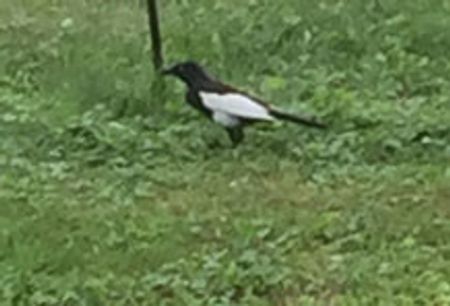
WHITE-WINGED BLACKBIRD?
Attached is a bird with strange markings that appeared at a feeder in Polk County. It looks like a magpie only the tail feathers are too short. One of the observers thought it was a mutation of a blackbird, as it was with other blackbirds. What are your thoughts?
Steve Price
Spring Valley
This is indeed a blackbird, specifically a common grackle. It exhibits leucism, which is caused by a genetic mutation that prevents the pigment melanin from being properly deposited in its feathers. Leucism also occurs in mammals.

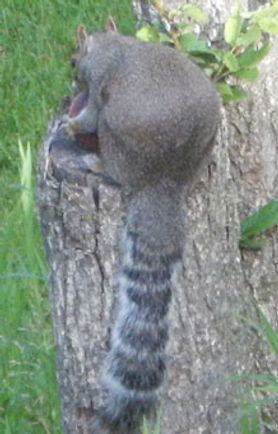
SQUIRRELS OF A DIFFERENT COLOR
I had always thought that black squirrels were few and far between until I moved to the city of Waupaca. I have seen as many as eight in my yard at one time and am wondering if there is something different about my area or if this is common in other towns also? Included is one of two squirrels that are hanging out this year. There are also three other black squirrels I have seen around with a white-tipped tail, very red tail, and one with white ears. My wife, Molly, happened to get a couple pictures of another squirrel (second photo) eating a peach. She has named him King Julian. We get the weirdest squirrels around here.
Andrew Stashek
Waupaca
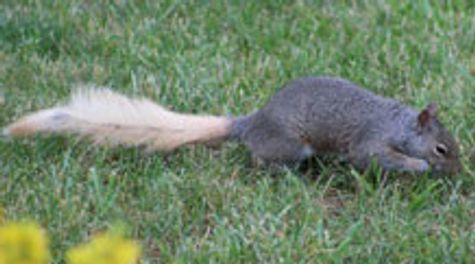
SQUIRRELS OF A DIFFERENT COLOR II
I took this photo (bottom) from my kitchen window on June 19 of this year. Couldn't believe my eyes. At first, from a distance, I thought it was a skunk, but as it got closer to my bird feeder, it obviously was not. I have seen albino deer, mink and a weasel, but never something like this.
Jim Shea
Omro
Mark Witecha, DNR's upland wildlife ecologist, provides this explanation: "These color variations all stem from genetic mutations. They are fairly common in squirrels, and do seem to occur in pockets. I remember seeing many black squirrels in Baraboo and Stevens Point."
Summer 2018
Summer 2018
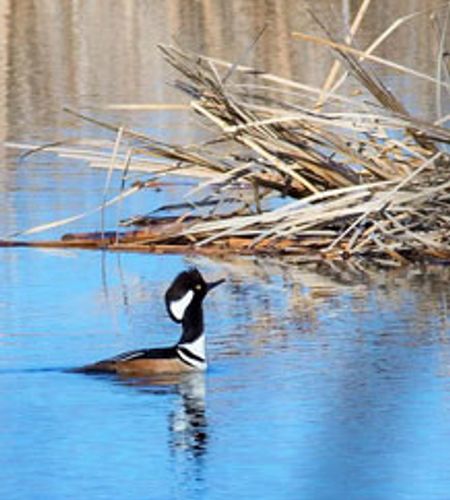
HORICON HOODIE
I just wanted to share this photo with the magazine that I captured at Horicon Marsh on March 19.
Ken Kearney
Thanks for sharing this great shot of a hooded merganser!

COVER PHOTO CREDIT
EDITOR'S NOTE: The day our Spring issue hit readers' mailboxes, we heard from Jennifer Nunn, Janesville, who was excited to see her photo on the front cover. We are happy to give her credit for the fine photo that perfectly conveyed the celebratory mood of the issue. Thanks, Jennifer!
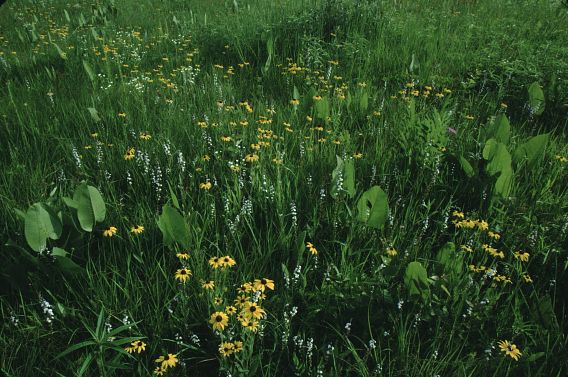 © DNR FILES
© DNR FILESFAVILLE GROVE FIXES
EDITOR'S NOTE: In the Spring story "Rooted in the past, a sanctuary grows," a mention of the "native Stoughton Faville Prairie Preserve" is a reference to the Faville Prairie State Natural Area, on the banks of the Crawfish River. The SNA, so designated in 1952, is owned by the University of Wisconsin and managed by the UW Arboretum with help from the Madison Audubon Society, especially during summer months. It should be noted that access to this SNA, one of the largest low prairie remnants in Wisconsin, is restricted because it is classified as a research area by UW. Also, in the story and an accompanying photo, a lily plant found at the sanctuary was misidentified. It is not the Turk's-cap lily but the nearly identical (at least to non-botanist folks) Michigan lily (Lilium michiganense).
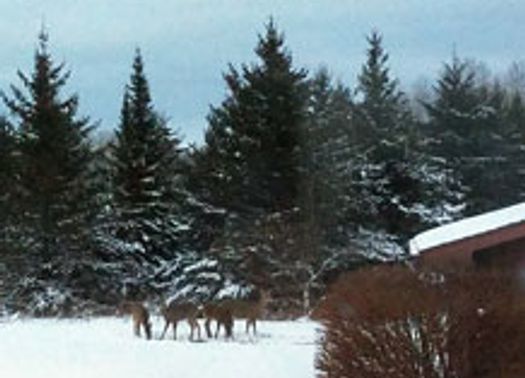
BACKYARD BEAUTY IN MICHIGAN
We are very blessed to have these awesome opportunities. This photo was taken in our yard.
Diane Henschel
Stephenson, Michigan
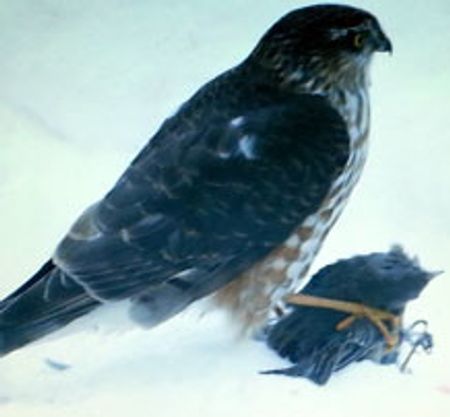
BIRD FEEDER DRAMA
Early in March, outside our kitchen window, a sharp-shinned hawk took a junco under the bird feeder. I grabbed the camera and the hawk was in no hurry to leave and posed for a few pictures. After five minutes it flew off with its lunch.
Richard A. Stoelb,
Howards Grove
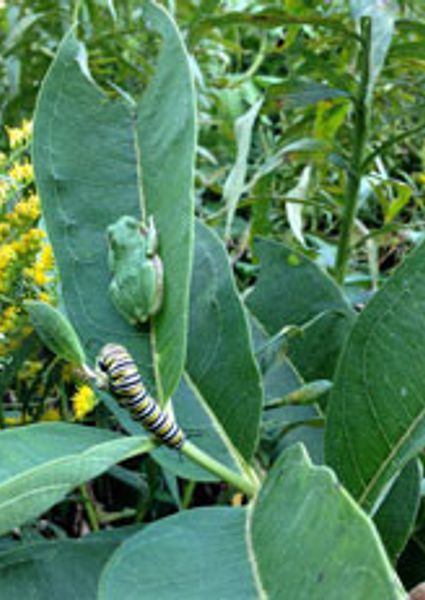
DOUBLE THE PLEASURE
While perusing the December 2017 issue of your magazine, I saw two separate photos from readers, one of a tree frog and one of a monarch caterpillar. I remembered I had taken a photo last fall that had both of these critters on a milkweed plant in our prairie. Love your magazine. So glad you will continue to publish it.
Mike Young
Hillpoint
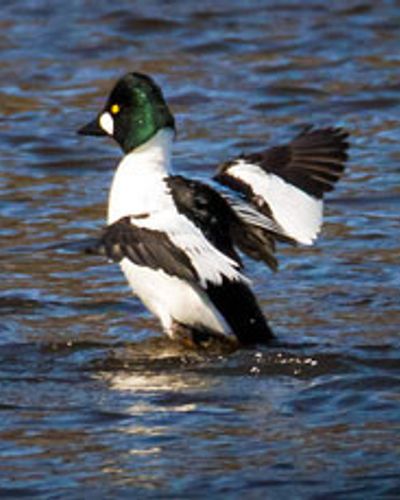
GOLDEN OPPORTUNITY
Thought you would like to see the photo I took Easter Sunday on ice-free water of the Yellow River (Burnett County) of a male common goldeneye duck.
Judy Curnow
Frederic
 © DNR FILES
© DNR FILESSUDSY SITUATION
I enjoyed reading about the history of the DNR (Spring 2018, "A DNR is born") and the photo of the foam below the Wisconsin Dells Dam from 1965. While it is much better today, I thought you might be interested in several photos I snapped on April 20, 2008, at the same location. The river was at a very high stage. I estimated the foam to be about 8 feet deep and it can be compared to the Dells tour boat in the photo. My wife and I live in the Portage/Wisconsin Dells area and are frequent geocachers in the Wisconsin state parks and are glad your magazine survives in its seasonal format.
I can remember when the river smelled like a paper mill and no one would eat the fish from the Wisconsin River. There are some beautiful places along the river, with the Dells being one of them. We have a geocache hidden down in the lower Dells that has been in place since 2001 and people are amazed when they actually get down in the lower part of the canyon and walk the shoreline to the cache. It sure gets them away from the touristy part of the river in a hurry.
John and Gail Bush
Portage
BETTER THAN TUNA
Thank you for Nicholas Saiia's article about suckers in the Spring 2018 issue ("Learn to love a sucker"). My husband and I have been fishing and eating redhorse since we grew up in the '60s. Our mothers fried the redhorse and we have memories of picking out bones as we ate. Then my dad got a recipe from a friend for canning redhorse. The recipe follows:
Canned redhorse: 2 T. salt; 2 T. salad oil; 6 T. vinegar; 6 T. catsup; Redhorse or sucker, filleted and cut into 1-inch pieces (a dozen medium-sized fish yields about 8 pints). Mix all ingredients and divide equally among sterilized pint canning jars. Pressure cook for 75 minutes at 15 pounds pressure.
Canned redhorse can be substituted for tuna in any recipe. It tastes better and doesn't have tuna's fishy smell. Fried patties with canned redhorse, mixed with crushed crackers and an egg, are good alone or on a bun. We especially like to make open-face sandwiches with canned redhorse mixed with mayo, chopped onion, celery, salt and pepper, topped with cheese and baked or broiled on our favorite bread.
Margie Novak
Kennan
Spring 2018
Spring 2018
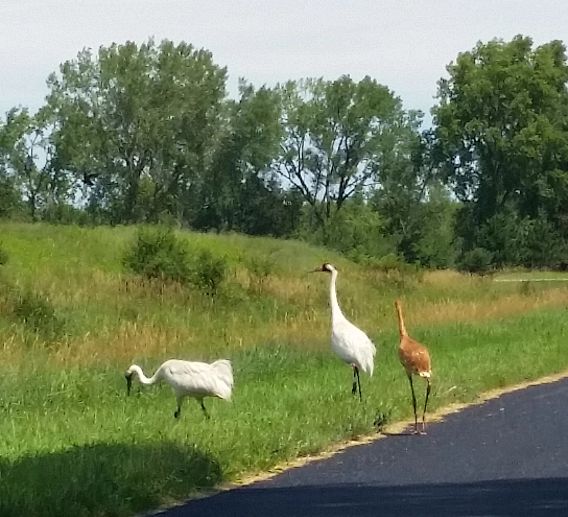
CRANE GANG
I took some pictures of a pair of whopping cranes with new addition over the summer. Not sure where you can use them in the magazine but I thought they were pretty neat.
Nick Checolinski
Appleton
HAPPY YOUNG HUNTER
Here's a picture of Adeline's nine-point buck that she bagged on Oct. 7 while hunting with her dad, Derek Frank. The deer was taken in the town of Sampson (youth hunt in northern Chippewa County). Addie has been a lucky hunter so far. Besides this very nice buck, she bagged a 350-pound black bear last year and a very nice tom turkey.
Wayne Frank
Chippewa County
SANDHILL’S PLEIN AIR APPEAL
Just finished reading the terrific article about the origins of the Sandhill Wildlife Area by Julie Hess and Anna Hess (October 2017). It seems to me SWA is one of the unsung successes of marshland preservation in Wisconsin.
I “discovered” it two years ago when looking for plein air painting locations. As one of the artists of record for the Tribune Building redevelopment project in Wisconsin Rapids, I was looking for places that celebrate the strengths of Wood County. I found that in spades at SWA.
Kudos to the Granges for their insight and hard work. It is great to know the back story of this area. Thanks for another wonderful issue of Wisconsin Natural Resources. I pray Wisconsinites will continue to value our natural resources for generations to come.
Jan Norsetter
Verona
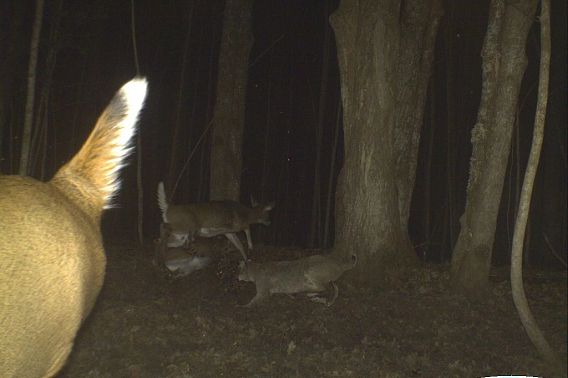
OH, SNAP!
I did my preseason scouting – lots of deer signs, no other hunters around. Wrong! There are three deer in this photo. That something you see on the ground by the back legs of the deer in the center is another deer that has been knocked over onto its back with the white belly exposed.
I can only imagine the young deer was knocked over in a panic escape by the other deer. The bobcat is in full stride and moments away from its prey. I did not go looking around for blood to see if the cat was successful because I did not view the camera card until later when I was home. I was then able to zoom in on the photo and observe what was captured.
Tom Long
Marengo

ABCs OF BUMBLE BEES
Reader Mike Fetting shared an email letter and photo, which were forwarded to the DNR’s Natural Heritage Conservation Program for response. Follow the correspondence below.
Last August my friends and I camped on the Willow Flowage (Oneida County). The picture is one of hundreds of endangered rusty patched bumble bees that were bouncing between the flowers at our campsite. They appeared to be thriving and couldn’t care less that we were there.
From the NHC: This is not a rusty patched bumble bee (Bombus affinis) but a tricolored bumble bee (Bombus ternarius). Tricolored bumble bees are a common bumble bee across the northern half of Wisconsin. The rusty patched bumble bee is a federally endangered species and hasn’t been seen in Oneida County since 1975. Thanks for your observation. To help researchers better understand the current bumble bee distribution across the state, please submit your observations to Bumble Bee Watch, bumblebeewatch.org.
I’ve since looked online — the similarities are so unfair! I was aware rusty patched bumble bees are very uncommon so was pretty excited. I was not aware of the tricolored before so didn’t realize there was something so similar. Thanks for the quick and informative response!
Mike Fetting
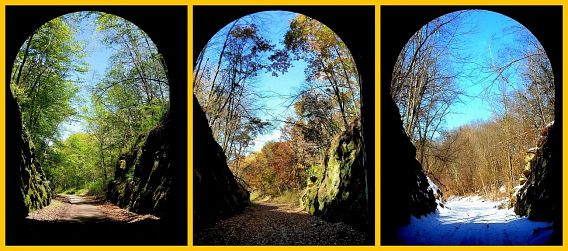
OMAHA TRAIL THROUGH THE SEASONS
These photos were taken at the entrance of the tunnel on the Omaha Trail.
Barb Harris
Richland Center
Editor’s note: The Omaha Trail is a paved bike trail maintained by Juneau County that runs south for 13 miles from Camp Douglas to Elroy. The 300-foot tunnel is located at the halfway point. Visit www.co.juneau.wi.gov/trails.html for more information.
OUR SENTIMENTS EXACTLY
I enjoyed Ron Weber’s article in the December Wisconsin Natural Resources magazine (“Driven by memories”). I know many readers will enjoy the piece, be able to relate to it and agree with his sentiments.
Dave Nelson, Editor
New York State Conservationist
I enjoyed reading Ron Weber's reflections on past deer hunts with brothers and friends, all of whom have now passed away. Weber describes so well the special memories of hunting with special people without regard to whether deer were taken.
I share similar special memories of many years of memorable and enjoyable Wisconsin deer hunts with my brother-in-law, who also passed away a few years ago. I am fortunate in that I am still able to hunt with my brother in Minnesota. However, I do miss my brother-in-law and those many, many special times in the field.
Norm Hanson
Roseville, Minnesota
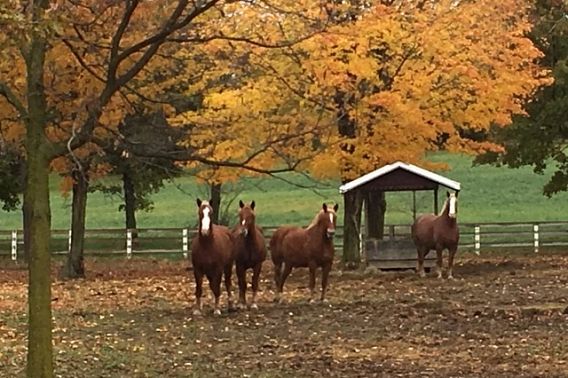
PATRON’S PRAISE
I am a Conservation Patron and now my son is as well. I have enjoyed your magazine for many years now and am very happy to hear this publication will continue. My wife and I came across this scene in October in Cottage Grove, as we were coming home from church on a Sunday morning.
What a beautiful classic fall Wisconsin scene! Feel free to use it in your publication if you feel it is of interest.
Cory Nelson
Cottage Grove
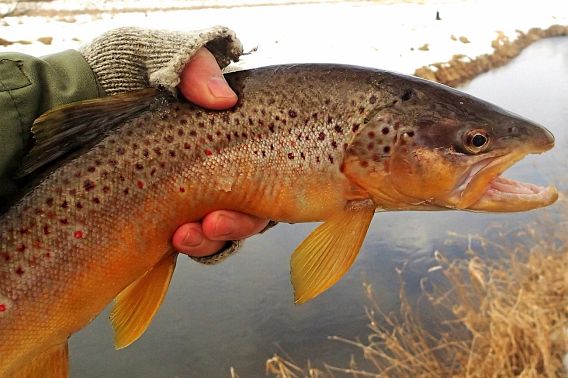
HANDLE TROUT WITH CARE
I fish alone many days and have struggled on a proper photo technique for that nice trout I just caught. Slime coat removal (from too much handling) and the trout basically holding its breath while you get that perfect shot are serious problems. If you are going to let that trout go, please let it be healthy after you have finished your photo. This is the way I do it.
First off, I have an adequate net. Many nets out there are woefully inadequate. It must have a deep, non-tapered bag. The net must be easy to unfasten from your back with your weak hand.
When I land my trout I immediately unhook the trout. A fish thrashing in the net with a hook still in its mouth can cause serious damage. Here comes the reason for the deep, wide net. That trout can revive after the battle submerged in the water and not be rubbing the sides of a small, non-tapered net and injuring itself.
You can do two different methods of preparation. First method is to stick the handle of the net into the soft bank with the trout in the net and totally submerged in the water. Ready your camera, take off the lens cap and focus. Reach into the net, wetting your hand, and take out the trout.
Hand placement is crucial here. Don't place your hand near the front of the trout and grip hard. You want to avoid crushing the organs. Take one photo, then revive the trout and let it go. This should take about five seconds of the trout being out of the water.
The other method involves placing the net handle between your knees instead of sticking it into the bank. All the other steps are the same. That net can get quite crusty after a few trout are landed in it, so rinse it thoroughly after each netting.
A short, sweet synopsis: Proper net, wet hand, minimal time out of water, hold trout gently, one photo and revive it before you release.
Len Harris
Richland Center
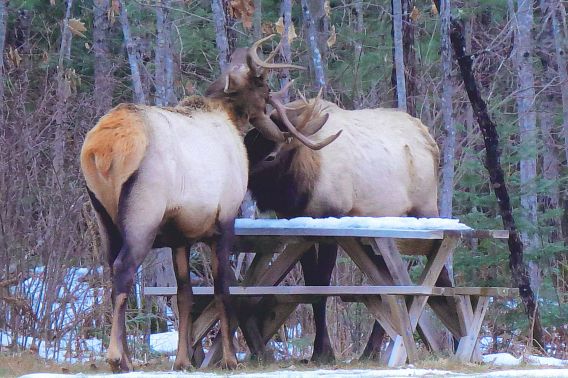
TABLE FOR TWO?
I captured these two bull elk fighting over the picnic table!
Jim Wallace
Winter
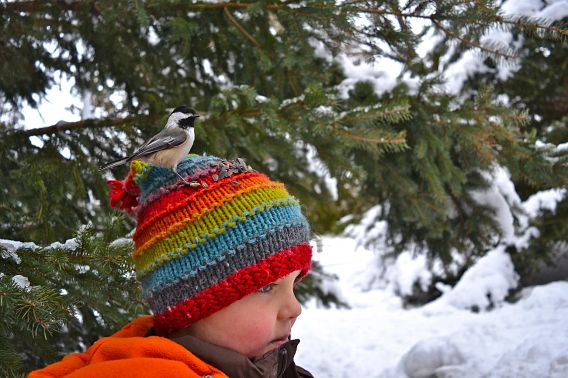
ATOP THE BIRD FEEDER
This little boy with the chickadee on his head is one of our grandsons, Max Spiegel. He was 6 years old at the time we took him to Peninsula State Park to feed the chickadees at the nature center. Max loved every minute of it.
Tim Sweet
Appleton
WISHIN’ FOR FISHIN’
As a longtime subscriber I enjoy seeing the magazine's pictures of people who love Wisconsin outdoors. In this photo from summer 2017, Claire Schnoor Loftus, age 4 with tackle in hand, contemplates a few of her family's big catches on Minocqua Lake.
Her grandfather, Dr. Jerald L. Schnoor, is an environmental engineer on faculty at the University of Iowa. I married his sister 36 years ago. We've all been enjoying Minocqua Lake for decades now, as did the generation before us.
We feel blessed to have the opportunity to enjoy such beauty and appreciate the role your magazine plays in promoting awareness of our unique and precious natural resources.
Fred Oaks
Nashotah
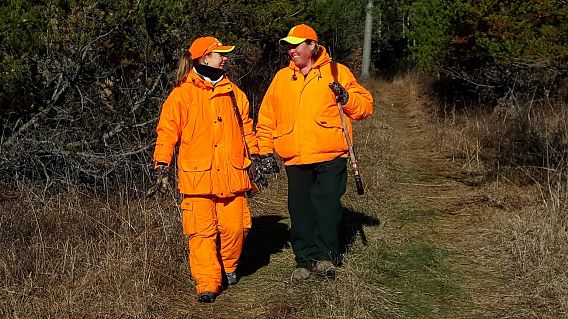
ALL SMILES IN THE FIELD
I thought I would pass along this picture of my daughter Madison and her cousin Jessica during last year's November firearm deer hunt. It is good to see women in the field these days, especially how much they are enjoying the activity.
Mike Skalecki

